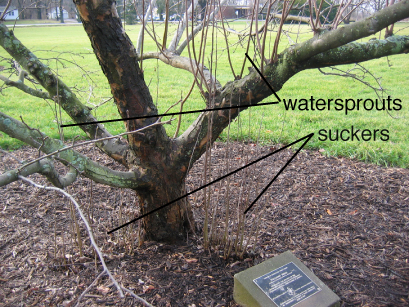Some landscape plants produce vigorous, upright stems that become troublesome as they out compete better-formed branches and shade out the rest of the plant. These remarkably fast growing upright stems are called “suckers” if they come from the root system, and “watersprouts” if they originate from other stems.
Ornamental crabapples are among the most notorious producers of these unwanted stems, but many other trees and shrubs can be afflicted, including contorted filbert, peach, apple and dogwoods.
While there are a few landscape plants that are supposed to have very upright habits, in most plants, this upright growth results in a weak architecture, in addition to causing overcrowding. Limbs with narrow branch angles are more prone to internal decay and breakage during storms.
Both suckers and watersprouts can and should be removed any time they occur, and it is often easier to see their architecture during the dormant season. The earlier these vigorous shoots are removed, the better, so don’t feel you must wait until winter. The succulent growth put on by suckers and watersprouts is often susceptible to attack by fungal pathogens, as well as sap-sucking insects, such as aphids. Keeping after these nuisance stems can be annoying, but better now than after several years of wood being laid down!
Suckers should be removed at or just below the soil line using sharp pruning shears. Watersprouts should be pruned back to their point of origin, avoiding injury to the remaining branch but also being careful to not leave a stub. If removed when they are very young, watersprouts can often be rubbed off with your gloved thumb, making summer a good time to say, “So long, suckers!”
